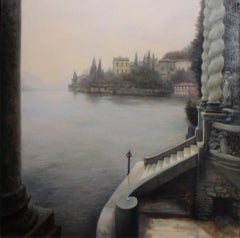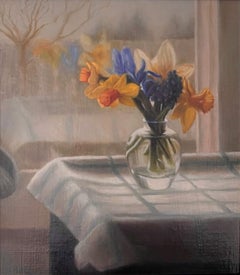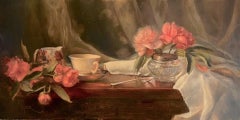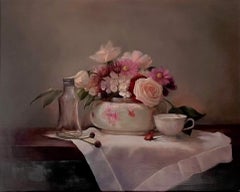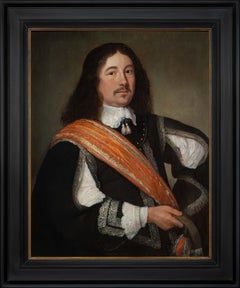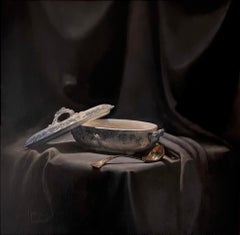Marsha Whitesides Piper Art
to
2
9
6
2
1
3
3
1
2
Overall Height
to
Overall Width
to
9
9
6,998
3,352
2,513
1,213
8
8
6
2
2
Artist: Marsha Whitesides Piper
Beets - Locally Grown
By Marsha Whitesides Piper
Located in Denver, CO
Beets - Locally Grown, 2009
Category
21st Century and Contemporary Marsha Whitesides Piper Art
Materials
Oil, Panel
Lake Como
By Marsha Whitesides Piper
Located in Denver, CO
Lake Como, 2020
Category
21st Century and Contemporary Marsha Whitesides Piper Art
Materials
Oil
First Blooms
By Marsha Whitesides Piper
Located in Denver, CO
First Blooms, 2012
Category
21st Century and Contemporary Marsha Whitesides Piper Art
Materials
Linen, Oil, Panel
Nutmeg in Situ
By Marsha Whitesides Piper
Located in Denver, CO
Nutmeg in Situ, 2020
Category
21st Century and Contemporary Marsha Whitesides Piper Art
Materials
Oil
Cut Glass III
By Marsha Whitesides Piper
Located in Denver, CO
Cut Glass III, 2010
Category
21st Century and Contemporary Marsha Whitesides Piper Art
Materials
Oil, Panel, Linen
Silver Rimmed Bowl
By Marsha Whitesides Piper
Located in Denver, CO
Silver Rimmed Bowl, 2010
Category
21st Century and Contemporary Marsha Whitesides Piper Art
Materials
Oil, Panel
Peonies and Crystal
By Marsha Whitesides Piper
Located in Denver, CO
Peonies and Crystal, 2011
Category
21st Century and Contemporary Marsha Whitesides Piper Art
Materials
Oil, Panel
The Center of the Sphere Doesn't Lie on its Surface
By Marsha Whitesides Piper
Located in Denver, CO
The Center of the Sphere Doesn't Lie on its Surface
Category
21st Century and Contemporary Marsha Whitesides Piper Art
Materials
Oil, Panel
Sand Dollar Bay
By Marsha Whitesides Piper
Located in Denver, CO
Sand Dollar Bay, 2019
Category
21st Century and Contemporary Marsha Whitesides Piper Art
Related Items
Venice at Dusk
By Lucien Whiting Powell
Located in Milford, NH
A fine Italian coastal oil painting with boats titled “Venice at Dusk” by American artist Lucien Whiting Powell (1846-1930). Powell was born in Levinworth Manor, Virginia, joined the 11th Virginia Cavalry at 17 and fought in the Civil War, pursuing his art career after the war, studying with Thomas Moran in Philadelphia and at the Pennsylvania Academy of the Fine Arts. He is also said to have studied in New York City, probably with Moran who moved there in 1872. He was an admirer of British artist J...
Category
Early 20th Century American Impressionist Marsha Whitesides Piper Art
Materials
Canvas, Oil, Panel
Portrait Gentleman Black Coat Orange Sash, Dutch Old Master, Oil on Panel c.1650
By Bartholomeus van der Helst
Located in London, GB
This exquisite portrait of a gentleman depicted in a sumptuous black coat edged with silver and slashed sleeves is an excellent example of the type of portrait fashionable in England and the Low Countries during the 17th century. The confident pose, striking orange sash - the colour of the house of Orange Nassau - and the leather gorget imbue the sitter with a sense of masculinity and power. The profusely decorated costume is of the highest quality and de rigueur of an elite class - the artist has carefully cultivated this portrait to emphasise the sitter’s wealth and standing in the society that he belonged to. The casual pose, with one arm resting on a hip, is much less formal than earlier decades, and it speaks of ‘sprezzatura’ – one’s appearance should not appear laborious, but instead, effortless.
The oil on cradled panel portrait can be dated to circa 1650 based on the hairstyle and the attire - small falling collar, short doublet (doublets reduced in size to just below the ribcage in the late 1650’s), and the type of slashed sleeves with the sleeve seams left open to reveal the white fabric.
The demand for portraits in the Netherlands was great in the 17th century. Bartholemeus van der Helst was considered to be one of the leading portrait painters of the Dutch Golden Age surpassing even Rembrandt as the most sought-after portraitist in Harlaam. The Dutch Golden Age, roughly spanning the 17th century, was a period when Dutch trade, science, military, and art were among the most acclaimed in the world. Dutch explorers charted new territory and settled abroad. Trade by the Dutch East-India Company thrived, and war heroes from the naval battles were decorated and became national heroes. During this time, The Dutch Old Masters began to prevail in the art world, creating a depth of realistic portraits of people and life in the area that has hardly been surpassed. The Golden Age painters depicted the scenes that their discerning new middle-class patrons wanted to see. This new wealth from merchant activities and exploration combined with a lack of church patronage, shifted art subjects away from biblical genres. Still life’s of items of everyday objects, landscapes, and seascapes reflecting the naval and trade power that the Republic enjoyed were popular. The new wealthy class were keen to have their portraits commissioned and many artists worked in this lucrative field. Such was the popularity of art that everyone had a painting, even the humble butcher, and hundreds of thousands of paintings were produced.
By tradition the sitter is Maarten Tromp (1598-1653) who was an Admiral in the Dutch Navy (the reverse of the portrait contains an old handwritten inscription “van Tromp”). Certainly, the distinctive orange sash is similar to those worn by officers of the Dutch army in the Netherlands who served under the Princes of Orange and the House of Nassau. However, it should be noted that the physiognomy differs from other images of Tromp.
Tromp was the oldest son of Harpert Maertensz, a naval officer and captain. He joined the Dutch navy as a lieutenant in July 1622 and was later promoted from captain to Lieutenant-Admiral of Holland and West Frisia in 1637. In 1639, during the Dutch struggle for independence from Spain, Tromp defeated a large Spanish fleet bound for Flanders at the Battle of the Downs, which marked an enormous change - the end of Spanish naval power. He was killed in action during the First Anglo-Dutch War in 1653 where he commanded the Dutch fleet in the battle of Scheveningen.
Gloves were an absolutely vital accessory and the elaborate pair in this portrait are embellished with threads of silk and precious metals and salmon-coloured lining. He wears only one glove and holds the other, providing an opportunity to better display the cuffs and detail on his right wrist and forearm. The gloves are probably made from the most prized leather which came from Spain, in particular from Cordova. Cordovan leather was tanned with a special vegetal process that left it both highly impermeable and divinely soft. King Charles I, posed in a rather relaxed manner for Daniel Mytens’s portrait in 1631, is wearing gloves and boots in matching Cordovan leather. The hide is thick, but you can see just how supple it is from the way the gauntlet dimples and the long boot legs fold over themselves, rippling and wrinkling at the ankles.
Apart from keeping hands warm the use of gloves during the 15th through the 19th centuries were full of symbolism and they were worn regardless of the season. They kept the skin unblemished - soft, smooth hands were considered highly attractive. This combination of necessity and proximity to bare skin made gloves a deeply personal gift and they took on a strong symbolic significance and were regarded as emblematic of fidelity and loyalty for hundreds of years. Such was the importance of their symbolism was that some gloves were never intended to be worn at all. Their luxury made them ideal gifts at court, and so in the 15th and 16th centuries, ambassadors often presented them as symbols of loyalty.
Until the mid-19th century, it was customary to give gloves as tokens to guests at weddings and to mourners at funerals. Gentleman often gifted their bride-to-be with a pair of gloves (the obligatory gift) and were handed over at the betrothal and put on display before the wedding took place. It was probably their direct contact with the skin that led to the eroticism of gloves. Not only were pairs often exchanged between lovers, but from the 16th to the 18th centuries, it was common practice to remove one glove and give it as a gift to a favourite. The idea of the item being presented still warm from the wearer’s hand is certainly suggestive. Following the death of King George IV, his executors purportedly found over a thousand mismatched ladies’ gloves among his possessions.
The sentiment of a 17th-century poem reveals the popularity of the practice: “Come to our wedding to requite your loves / Shew us your hands and we’ll fit you with gloves.” Such generosity might be pricey for the hosts, but gloves of varying quality could be offered depending on the status of the recipient. Pairs made with the finest Spanish leather might be reserved for immediate family, while coarse sheep’s leather could be distributed among the servants and tradesmen. The apportioning of quality according to class provided a very clear message of the gloves’ intended use. For refined guests, they were decoration; for the lower classes, they were functional.
Bartholomeus van der Helst...
Category
17th Century Old Masters Marsha Whitesides Piper Art
Materials
Oil, Wood Panel
H 38.59 in W 31.89 in D 2.76 in
Summer day. Oil on cardboard, 40x50 cm
By Alfejs Bromults
Located in Riga, LV
Summer day. Oil on cardboard, 40x50 cm
Alfejs Bromults (1913.3.IV - 1991.11.I)
His first professional education was at National University at studies to R.Suta, J. Bine and G. Skil...
Category
Late 20th Century Impressionist Marsha Whitesides Piper Art
Materials
Oil, Cardboard
That Golden Hour-modern art impressionist seascape vivid colour-contemprary art
Located in London, Chelsea
"That Golden Hour" by Nick Vivian is a breathtaking depiction of nature's most enchanting spectacle - the sunset. Vivid colors dance across the canvas, capturing the animated hues of...
Category
21st Century and Contemporary Abstract Impressionist Marsha Whitesides Piper Art
Materials
Linen, Oil
Nicholas VivianThat Golden Hour-modern art impressionist seascape vivid colour-contemprary art, 2024
H 39.38 in W 39.38 in D 1.19 in
"Cotton Candy Clouds Over Sag Harbor" contemporary impressionist landscape
By Tim McGuire
Located in Sag Harbor, NY
A bright harbor scene with fluffy clouds filling the air in Mcguire's signature impressionist style.
Artist Bio:
Tim McGuire Born in 1971, Tim McGuire grew up in Buffalo, NY. After...
Category
21st Century and Contemporary Impressionist Marsha Whitesides Piper Art
Materials
Linen, Oil
Double Portrait of Sir John Rivers 3rd Baronet of Chafford, and Lady Anne Rivers
Located in London, GB
This magnificent grand-scale work, offered by Titan Fine Art, formed part of a collection of family pictures and heirlooms of the Rivers Baronets and their descendants for over 325 years, before it was dispersed by the last in the line in 1988. The work was painted by the most technically proficient painter in England after the death of Van Dyck, and the dominant court painter to Charles II and James, Duke of York, Sir Peter Lely. It is no surprise that for years Lely had no serious rivals, was enormously influential and successful, and one of the country’s most important painters – and his work influenced countless artists over generations. The exquisite carved and gilded auricular frame is an astounding work of art in itself.
The sitters in this exquisite double portrait are Sir John Rivers, who succeeded as the 3rd Baronet Chafford in 1657 (c.1638 - c. 1679), and his wife, Lady Anne Hewitt (c.1640-c.1689). They are seated in an outdoor setting beside a fountain modelled as a female figure with water issuing into a scallop-shell. The water, the elaborate sculpted fountain with its scallop-edged bowl, and the open shell in her hand are symbols of fertility - as such they make an appropriate allusion to Lady Anne’s potential as wife and mother, recalling Proverbs, chapter 5, verse 18: “Let thye fountain be blessed, and rejoice in the wife of thye youth”. This reference was realised, as Sir John and Lady Anne produced at least six children; their son George (1665-1734) became 4th Baronet of Chafford. The composition, thus, represents a celebration of marriage and was likely commissioned around the time of the betrothal (the marriage took place 26th Feb 1662 or 1663). The statues in the left margin are 'Youth and 'Old Age' and are a typical form of Memento Mori reminding virile young man that even they will lose their youth and grow old.
The Rivers family, originally of Kent, traces its history to Sir Bartholomew Rivers, in the reign of Edward IV. The family included several prominent members including several knights, a Commander in the King's Army, a steward of a ducal estate, a Lord-Mayor of London, and an M.P. John Rivers (c.1659-c.1651) was made 1st Baronet of Chafford in 1622 by King James I. The Chafford estate was the family seat and it remained so until the early 1700s with the death of Sir George Rivers, 4th Baronet (1665–1734), whose sons had all died. The Chafford estate was left to his daughters while the baronetcy passed to nephew John Rivers, 5th Baronet (c. 1718–1743), and then Sir John’s brother, Sir Peter Rivers-Gay, 6th Baronet (c. 1721–1790).
Upon Sir Peter Rivers Gay's death the estate passed to his eldest son, Sir Thomas Rivers Gay, 7th Baronet (c. 1770–1805). Sir Thomas, dying in 1805 with no children, bequeathed the estate to his mother Dame Martha Rivers Gay, who managed the estate until 1834 when she settled it on the then Sir Henry Rivers, 9th Baronet (c. 1779–1851) her younger son, before dying shortly thereafter in 1835. Sir Henry had married in 1812 to Charlotte Eales, with whom he had 6 sons and 8 daughters. Upon his death in 1851 the estate passed to his eldest surviving son Sir James Francis Rivers, 10th Baronet (1822–1869). Sir James married Catherine Eastcott in 1867 but died childless in 1869, and the estate passed to his only surviving brother Sir Henry Chandos Rivers, 11th Baronet (1834–1870) but he died a year later in 1870 also childless; with no male heir the Baronetcy was therefore extinguished.
The estate was bequeathed, in trust, by Sir Henry Chandos Rivers to Thomas Frederick Inman, a solicitor of Bath, who then managed the estate as a trustee on behalf of Sir Henry Chandos Rivers' sister Katherine Rivers (c.1826-1895). It then passed to Katherine River’s daughter, Katherine Wall (born c.1855), who had also inherited Worthy Park House from her father, George Alfred Ellis Wall (1825-1875).
Until 1958 our portrait is known to have hung at Worthy Park House. Upon Katherine Wall’s death, the Rivers estate passed to her daughter, Katherine Eleonora Rivers Fryer (1889-1963), who married Colonel James Alexander Butchart 1877-1853. In 1958 the family sold Worthy Park House but our portrait was loaned to Southampton Museum and Art Gallery. After the death of Katherine and Colonel James, the estate was left to their only son, Charles Bruce Rivers Butchart (1917-2005) and upon Charles’ retirement to a nursing home in 1988, and without heirs, our portrait, along with the residual assets of the Rivers estate were sold, thus ending over 325 years of continual family ownership.
Lady Anne Rivers is thought to have been born circa 1640. She was the fourth child of the second marriage of Sir Thomas Hewitt (or Hewett) (1606-1662), 1st Baronet of Pishobury, Herts, and his wife Margaret Lytton (died 1689). Sir Thomas was an English landowner and M.P. for Windsor and upon the English Restoration...
Category
17th Century Old Masters Marsha Whitesides Piper Art
Materials
Canvas, Oil
H 70.08 in W 82.29 in D 5.91 in
Road to the home at summer evening. 1973, oil on cardboard, 49x69 cm
By Alfejs Bromults
Located in Riga, LV
Road to the home at summer evening.
1973, oil on cardboard, 49x69 cm
Alfejs Bromults (1913.3.IV - 1991.11.I)
His first professional education was at National University at studies...
Category
1970s Realist Marsha Whitesides Piper Art
Materials
Oil, Cardboard
H 19.3 in W 27.17 in D 0.79 in
Portrait of Gentleman, Thomas Bruce, Earl of Elgin c.1638 Manor House Provenance
Located in London, GB
Titan Fine Art present this picture which formed part of a historic collection of an English aristocratic family, Lord and Lady Sandys at their magnificent baroque and Regency Grade-I listed family home, Ombersley Court. The house was among the most fascinating survivals of its kind in this country. The atmospheric interiors were distinguished above all for the works of art associated with two key moments in national history and, more specifically, to the roles of Colonel the Hon. John Russell in the Civil War and the reign of King Charles II and of Lord Arthur Hill, later 2nd Baron Sandys, in the Peninsular War. The collection was acquired or commissioned over five centuries and remained at Ombersley Court until its recent sale, the first in 294 years. This painting hung in The Great Hall (see photo).
This charming portrait is an example of the type of small-scale panel portraits, often of splendid beauties of the time, that became fashionable from about the first quarter of the seventeenth century. The sitter has been depicted wearing a low-cut silk dress with the wide billowing sleeves typical of the late 1630’s. The simplicity of the ensemble is reinforced by the absence of lace on either the collar or cuffs. At this time gone are the complicated layers of fabrics, and now replaced with understated elegance of plain silk (satin and taffeta were most popular), with only a couple of focal points as accessories. There is an abundance of the accessory par excellence – pearls, and they are worn as a necklace, on her attire, and as earrings; the pear-shaped earrings are called ‘unions excellence’ reflecting the difficulty of finding perfectly matched pearls of such large size. They could range up to 20 millimetres in diameter. There is a splendid display of gold, diamond and pearl jewellery which is an obvious sign of her wealth.
The portrait is thought to represent Thomas Bruce (1596-1654), Earl of Elgin. The physiognomy and features in our portrait strongly correlate to a portrait of the Earl, by Cornelius Johnson (1593-1661), painted circa 1638, and is held at Kenwood House, London. Another painting from Ombersley Court, also with Titan Fine Art, is contemporaneous to ours and is thought to represent the Earl’s wife, Diana Cecil, 1st Countess of Elgin (c.1603-1654) - it appears to have derived from Cornelius Johnson’s depiction of the Countess circa 1638, also at Kenwood House. During the 1630’s Johnson painted a number of portraits, obviously influenced by Van Dyke. Here, Theodore Russel, who worked in the studios of both Van Dyle and Johnson, and later specialised in small scale reproductions of his master’s works, modelled the head, with the striking large dark eyes, on Cornelius Johnson, and the attire on Anthony van Dyke. There are also other portraits by Johnson of the sitter with very similar facial features to that of the sitter in ours. Theodore Russel and Cornelius Johnson also had a family connection as it is thought that Russel’s step-mother was a sister of Johnson.
Thomas Bruce, 1st Earl of Elgin, was a prominent Scottish nobleman who held titles such as the 3rd Lord Bruce of Kinloss. He resided at Houghton House in Bedfordshire and played a significant role in the political and social landscape of his time. His legacy as an Earl and Lord continues to be remembered in history.
Thomas Bruce, born in Edinburgh in 1599, inherited the Scottish peerage title as the 3rd Lord Bruce of Kinloss at the age of 13 following his brother's untimely death in a duel. The family's estates, including Whorlton Castle and manor, were granted by King James I of England to Thomas's father, with the wardship of Thomas and the estates entrusted to his mother until he reached the age of 21. He maintained a strong connection with King Charles I's court during the Personal Rule, receiving titles of honour and prestigious roles throughout the years.
Thomas Bruce was married twice in his lifetime. His first marriage was to Anne Chichester in 1622. Ann died in 1627, the day after giving birth to their only child, Robert Bruce, who later became the 1st Earl of Ailesbury. On 12 November 1629, Thomas Bruce married Lady Diana Cecil, the daughter of William Cecil and widow of Henry de Vere. The marriage was childless, but Diana brought significant estates with her. Thomas Bruce died on 21 December 1663 at the age of 64.
This oil on panel portrait has been well cared for over its life, which spans almost four centuries. Having recently undergone a treatment to remove an obscuring discoloured varnish, it can be fully appreciated, and attributed to Theodore Russel.
Once owned by Evesham Abbey, the manor of Ombersley was acquired by the Sandys family in the early 1600s, when Sir Samuel Sandys, the eldest son of Edwin Sandys, Bishop of Worcester and later Archbishop of York, took a lease on the manor, before receiving an outright grant in 1614. The present house, Ombersley Court, dates from the time of Samuel, 1st Lord Sandys, between 1723 and 1730. The house itself is a fine example of an English Georgian country house set in rolling countryside and surrounded by Wellingtonias, planted to commemorate the Battle of Waterloo by Arthur Hill, 2nd Baron Sandys, who played a distinguished part in the battle and was one of the Duke of Wellington’s aides de camp. The Duke also stayed in the house and in the Great Hall, was the Waterloo banner which was brought to the house by Sir Arthur Hill, aide-de-camp to the Duke of Wellington, who succeeded his mother, the Marchioness of Downshire as 2nd Lord Sandys. Further Waterloo memorabilia are kettle drums from battle. The family had a strong tradition of military and political service, dating back to the 17th century, and this was also reflected in the fine collection of portraits and paintings in the house. In short, Ombersley represented a vital aspect of British history. The house and more especially the collection were of the greatest historical importance. Houses that have remained in the possession of the same family for as many as three centuries have become increasingly rare.
Through this portrait, collectors have a chance to acquire a piece of British history and an evocative vestige of a glittering way of life, which is now gone.
Presented in a fine period frame.
Theodore Russell, or Roussel, was born in London in 1614. His father came from Bruges to England and was the Royal Stuart jeweller. His apprenticeship was spent in the studio of his uncle, Cornelius Johnson, with whom he lived for about nine years. Sometime after 1632, he is said to have worked as an assistance to Van Dyck. He executed numerous copies of portraits by his famous master and other notable painters, also painting original works. He is particularly remembered for his portraits of Charles II at Woburn Abbey and James II at the Palace of Holyrood. His son, Antony Russel (c.1663–1743) was also a portrait-painter and is said to have studied under John Riley. Several of his copies were in the Royal Collections, and among the nobility.
Provenance
Richard Hill...
Category
17th Century Old Masters Marsha Whitesides Piper Art
Materials
Oil, Wood Panel
H 18.9 in W 16.15 in D 1.58 in
Mini Shoreline-original impressionism Cornish seascape painting-CONTEMPORARY Art
Located in London, Chelsea
"Mini Shoreline" by Lenny Cornforth is a captivating original seascape painting that transports viewers to the tranquil shores of Cornwall. Crafted with oil on canvas in the style of...
Category
21st Century and Contemporary Realist Marsha Whitesides Piper Art
Materials
Canvas, Oil
Free Shipping
H 7.88 in W 7.88 in D 1.19 in
Promise of a New Day - modern art impressionist seascape vivid -contemporary art
Located in London, Chelsea
My apologies for the oversight. Here's the revised description:
"Promise of a New Day" by Nick Vivian is a radiant testament to the hope and possibilities that come with the dawn of...
Category
21st Century and Contemporary Abstract Impressionist Marsha Whitesides Piper Art
Materials
Linen, Oil
H 35.44 in W 47.25 in D 1.19 in
Portrait of a Lady Diana Cecil, Countess of Elgin c.1638, Manor House Provenance
Located in London, GB
Titan Fine Art present this picture which formed part of a historic collection of an English aristocratic family, Lord and Lady Sandys at their magnificent baroque and Regency Grade-I listed family home, Ombersley Court. The house was among the most fascinating survivals of its kind in this country. The atmospheric interiors were distinguished above all for the works of art associated with two key moments in national history and, more specifically, to the roles of Colonel the Hon. John Russell in the Civil War and the reign of King Charles II and of Lord Arthur Hill, later 2nd Baron Sandys, in the Peninsular War. The collection was acquired or commissioned over five centuries and remained at Ombersley Court until its recent sale, the first in 294 years. This painting hung in The Great Hall (see photo).
This charming portrait is an example of the type of small-scale panel portraits, often of splendid beauties of the time, that became fashionable from about the first quarter of the seventeenth century. The sitter has been depicted wearing a low-cut silk dress with the wide billowing sleeves typical of the late 1630’s. The simplicity of the ensemble is reinforced by the absence of lace on either the collar or cuffs. At this fashion moved away from complicated layers of fabrics to an understated elegance of plain silk (satin and taffeta were most popular) with only a couple of focal points as accessories. However, obligatory for any respectable woman, pears are shown in abundance, as a necklace, on the dress attire, and pear-shaped earrings called ‘unions excellence’ reflecting the difficulty of finding perfectly matched pearls of such large size. They could range up to 20 millimetres in diameter. There is a splendid display of gold, diamond and pearl jewellery which is an obvious sign of her wealth.
The subject is thought to be Diana Bruce née Cecil, 1st Countess of Elgin (c.1603-1654). The physiognomy and features strongly correlate to a portrait of the countess by Cornelius Johnson (1593-1661), painted circa 1638, at Kenwood House, London. Another painting from Ombersley Court, also with Titan Fine Art, is contemporaneous to this and is thought to represent the countess’s husband, Thomas Bruce, 1st Earl of Elgin (1599-1663) – it appears to have derived from Cornelius Johnson’s portrait of the Earl, of circa 1638, also at Kenwood House. During the 1630’s Johnson painted a number of portraits, obviously influenced by Van Dyke. Here, Theodore Russel, who worked in the studios of both Van Dyle and Johnson, and later specialised in small scale reproductions of his master’s works, appears to have modelled the head, with the striking large dark eyes, on Cornelius Johnson, and the attire on Anthony van Dyke. Theodore Russel and Cornelius Johnson also had a family connection as it is thought that Russel’s step-mother was a sister of Johnson.
Diana Cecil, Countess of Oxford (1596–1654), later Countess of Elgin, was an English aristocrat. She was probably the middle daughter of the three daughters of William Cecil, 2nd Earl of Exeter and Elizabeth Drury. Her first husband, Henry de Vere, 18th Earl of Oxford, died in battle only 18 months after their marriage in 1624. She married her second husband Thomas Bruce (1599-I663) in 1629, becoming the Countess of Elgin in 1633. Her portrait was presumably painted at a similar time as the companion portrait of her husband, the Earl of Elgin. She died in 1654, outlived by her husband and leaving no children. A large monument exists of the countess in her burial shroud at Ailesbury Mausoleum, Bedfordshire.
The work has been well cared for over its life, which spanning almost four centuries, and having recently undergone a treatment to remove an obscuring discoloured varnish, it can be fully appreciated, and attributed to Theodore Russel.
Once owned by Evesham Abbey, the manor of Ombersley was acquired by the Sandys family in the early 1600s, when Sir Samuel Sandys, the eldest son of Edwin Sandys, Bishop of Worcester and later Archbishop of York, took a lease on the manor, before receiving an outright grant in 1614. The present house, Ombersley Court, dates from the time of Samuel, 1st Lord Sandys, between 1723 and 1730. The house itself is a fine example of an English Georgian country house set in rolling countryside and surrounded by Wellingtonias, planted to commemorate the Battle of Waterloo by Arthur Hill, 2nd Baron Sandys, who played a distinguished part in the battle and was one of the Duke of Wellington’s aides de camp. The Duke also stayed in the house and in the Great Hall, was the Waterloo banner which was brought to the house by Sir Arthur Hill, aide-de-camp to the Duke of Wellington, who succeeded his mother, the Marchioness of Downshire as 2nd Lord Sandys. Further Waterloo memorabilia are kettle drums from battle. The family had a strong tradition of military and political service, dating back to the 17th century, and this was also reflected in the fine collection of portraits and paintings in the house. In short, Ombersley represented a vital aspect of British history. The house and more especially the collection were of the greatest historical importance. Houses that have remained in the possession of the same family for as many as three centuries have become increasingly rare.
Through this portrait, collectors have a chance to acquire a piece of British history and an evocative vestige of a glittering way of life, which is now gone.
Presented in a fine period frame.
Theodore Russell, or Roussel, was born in London in 1614. His father came from Bruges to England and was the Royal Stuart jeweller. His apprenticeship was spent in the studio of his uncle, Cornelius Johnson, with whom he lived for about nine years. Sometime after 1632, he is said to have worked as an assistance to Van Dyck. He executed numerous copies of portraits by his famous master and other notable painters, also painting original works. He is particularly remembered for his portraits of Charles II at Woburn Abbey and James II at the Palace of Holyrood. His son, Antony Russel (c.1663–1743) was also a portrait-painter and is said to have studied under John Riley. Several of his copies were in the Royal Collections, and among the nobility.
Provenance
Richard Hill...
Category
17th Century Old Masters Marsha Whitesides Piper Art
Materials
Oil, Wood Panel
H 18.9 in W 16.15 in D 1.58 in
Portrait of Abigail, Countess of Kinnoull, Signed Dated Godfrey Kneller Painting
By Kneller Godfrey
Located in London, GB
Presented by Titan Fine Art, this elegant and beautiful portrait depicts Abigail Hay, Lady Dupplin, Countess of Kinnoull; it is an excellent example of English portraiture from the f...
Category
18th Century Old Masters Marsha Whitesides Piper Art
Materials
Canvas, Oil
H 57.09 in W 47.25 in D 2.37 in
Previously Available Items
Lee's Peonies
By Marsha Whitesides Piper
Located in Denver, CO
Lee's Peonies, 2014
Category
21st Century and Contemporary Marsha Whitesides Piper Art
Materials
Oil, Panel
The Tarnished Ladle
By Marsha Whitesides Piper
Located in Denver, CO
The Tarnished Ladle, 2010
Category
21st Century and Contemporary Marsha Whitesides Piper Art
"Cherries" Oil Painting
By Marsha Whitesides Piper
Located in Denver, CO
Marsha Whitesides Piper's (US based) "Cherries" is an oil painting depicting a silver reflective bowl overflowing with red cherries spilling over onto the dark grey table...
Category
2010s Academic Marsha Whitesides Piper Art
Materials
Oil
"Cherries and Tea" Oil Painting
By Marsha Whitesides Piper
Located in Denver, CO
Marsha Whitesides Piper's (US based) "Cherries and Tea" is an oil painting depicting six red cherries placed with a reflective tea kettle in a dark interior.
Artist statement:
The ...
Category
2010s Academic Marsha Whitesides Piper Art
Materials
Oil
"Grapes" Oil Painting
By Marsha Whitesides Piper
Located in Denver, CO
Marsha Whitesides Piper's (US based) "Grapes" is an oil painting of red grapes with a reflective bowl in warm grey interior
Artist statement:
The oil paintings of Marsha Whitesides...
Category
2010s Academic Marsha Whitesides Piper Art
Materials
Oil
Marsha Whitesides Piper art for sale on 1stDibs.
Find a wide variety of authentic Marsha Whitesides Piper art available for sale on 1stDibs. You can also browse by medium to find art by Marsha Whitesides Piper in oil paint, paint, panel and more. Not every interior allows for large Marsha Whitesides Piper art, so small editions measuring 8 inches across are available. Customers who are interested in this artist might also find the work of Chandra Bhattacharya, Sergei Inkatov, and Ryan Pickart. Marsha Whitesides Piper art prices can differ depending upon medium, time period and other attributes. On 1stDibs, the price for these items starts at $920 and tops out at $5,400, while the average work can sell for $3,280.

